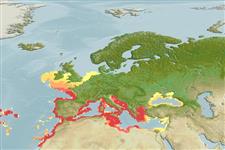Common names from other countries
Environment: milieu / climate zone / depth range / distribution range
Ecologia
marinhas demersal; não migratória; intervalo de profundidade ? - 800 m (Ref. 4570). Temperate; 55°N - 25°N, 32°W - 42°E
Eastern Atlantic: British Isles to the Azores, and the Canary Islands, including Morocco, the Mediterranean Sea and the Black Sea.
Comprimento de primeira maturação / Tamanho / Peso / Idade
Maturity: Lm 14.4, range 10 - ? cm
Max length : 40.5 cm TL macho/indeterminado; (Ref. 33903); common length : 15.0 cm TL macho/indeterminado; (Ref. 3397); peso máx. publicado: 870.00 g (Ref. 40637)
Descrição suscinta
Chaves de identificação | Morfologia | Morfometria
Espinhos dorsais (total) : 12; Raios dorsais (total) : 7 - 9; Espinhos anais: 3; Raios anais : 4 - 6. This species is distinguished by the following characters: D XII,7-9 with the last divided at base; pectoral fin rays 16-18, uppermost branched pectoral fin ray is usually the third (rarely second to fourth); lacrimal usually with 2 spines over maxilla that point at nearly right angle from each other, posterior pointing ventrally and slightly anteriorly; occipital pit is well-developed; anteriormost mandibular lateral line pores are widely separated; scales small, emarginate, no distinct ctenii; scale rows in longitudinal series 56-60; no scales on chest and pectoral fin base; cirri well developed over entire head and body, no cirri on lower jaw (Ref. 122805).
Solitary and sedentary. Common among rocks and algae. Feeds on small fishes (gobies, blennies), crustaceans and other invertebrates (Ref. 4570).
Ciclo de vida ou comportamento de acasalamento
Maturities | Reprodução | Spawnings | Egg(s) | Fecundities | Larvas
Fricke, R., D. Golani, B. Applebaum-Golani and U. Zajonz, 2018. Scorpaena decemradiata new species (Teleostei: Scorpaenidae) from the Gulf of Aqaba, northern Red Sea, a species distinct from Scorpaena porcus. Scientia Marina 82(3):1-16. (Ref. 122805)
Status na Lista Vermelha da UICN (Ref. 130435)
CITES (Ref. 128078)
Not Evaluated
Ameaça para os humanos
Traumatogenic (Ref. 4690)
Uso pelos humanos
Pescarias: pouco comercial; Aquário: Espécies comerciais
Ferramentas
Relatórios especiais
Baixar XML
Fontes da internet
Estimates based on models
Preferred temperature (Ref.
115969): 11.2 - 15.8, mean 13.9 (based on 232 cells).
Índice de diversidade filogenética (Ref.
82804): PD
50 = 0.5000 [Uniqueness, from 0.5 = low to 2.0 = high].
Bayesian length-weight: a=0.01318 (0.01172 - 0.01483), b=3.03 (3.00 - 3.06), in cm Total Length, based on LWR estimates for this species (Ref.
93245).
Nível Trófico (Ref.
69278): 3.9 ±0.2 se; based on diet studies.
Resiliência (Ref.
120179): médio(a), tempo mínimo de duplicação da população 1,4 - 4,4 anos (K=0.2-0.5; tmax=8).
Fishing Vulnerability (Ref.
59153): Moderate to high vulnerability (47 of 100).
Climate Vulnerability (Ref.
125649): Moderate vulnerability (38 of 100).
